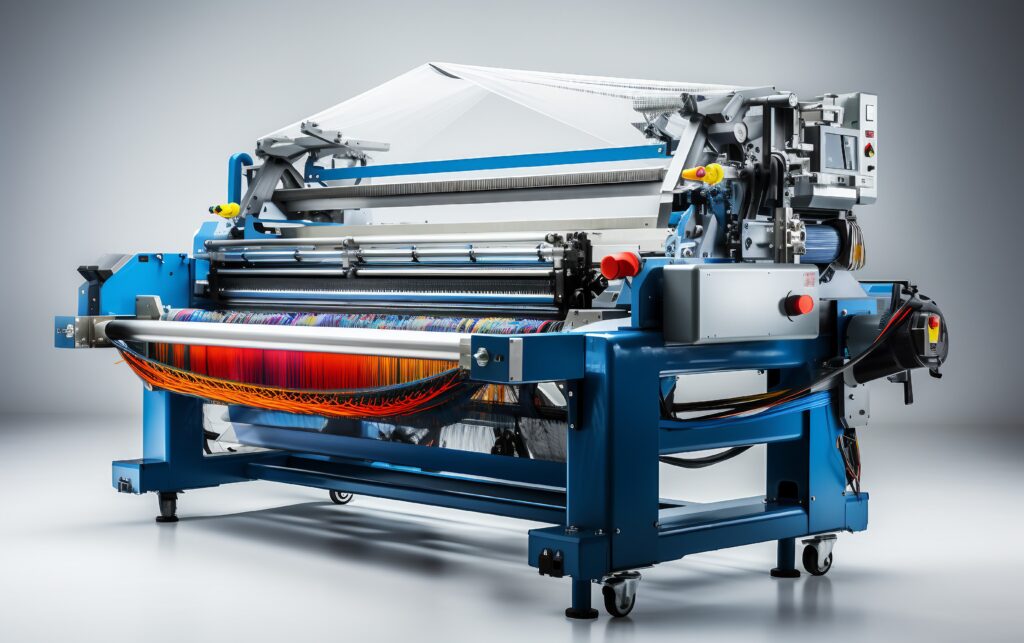The textile industry always changes with better technology. One big innovation is the air jet loom. This modern weaving machine has many advantages over traditional looms. That’s why it is a popular choice for making high-speed and high-quality fabric. In this blog, we will cover the features, benefits, and workings of air jet looms. We will also explore how they differ from the shuttle looms.
Working Principle of Air Jet Loom
Understanding the air jet loom’s working principle is crucial. It helps you calculate & optimize its efficiency and effectiveness for the better. The working principle involves several key steps:
- Warp Shedding:
Air jet looms, like any other looms, start with warp shedding. This is where the warp yarns separate to form a shed. This is achieved using heald frames or harnesses that lift and lower the warp yarns.
- Weft Insertion:
The unique feature of the air jet loom is the weft insertion method. A jet of compressed air propels the weft yarn through the shed at high speed. The Nozzles and air valves control this process & ensure precise and efficient weft insertion.
- Beat-Up:
After the weft yarn is inserted, the reed beats it against the cloth’s fell & ensures that the yarn is firm in the fabric. This step is critical for achieving the desired fabric density and texture.
- Take-Up and Let-Off:
The Take-Up winds fabric onto a cloth beam, while the Let-Off releases warp yarns from a warp beam at a set rate. These mechanisms work in tandem to maintain consistent fabric tension and quality.
Features of Air Jet Loom
Air jet looms have a unique weft insertion method. In it, a jet of air propels the weft yarn through the shed.
The key features of air jet looms include:
- High-Speed Operation: Air jet machines are known for their high-speed weaving. They can reach speeds of up to 1,200 picks per minute (ppm). This speed significantly boosts air jet loom production per day. It’s ideal for large-scale manufacturing.
- Efficient Weft Insertion: The air jet system ensures quick weft insertion. It cuts the risk of yarn breaking and boosts weaving efficiency. This system can handle a variety of yarn types, including synthetic and blended yarns.
- Advanced Control Systems: Modern air jet looms have advanced electronic control systems. These systems monitor and adjust various parameters in real time. They also ensure optimal machine performance and fabric quality.
- Energy Efficiency: The air jet loom is designed for energy efficiency. They are despite their high speed. Using compressed air reduces the machine’s complexity. This leads to lower power use.
- Versatility: Air jet looms are versatile. They can make a wide range of fabrics, from light to heavy textiles. This versatility makes them suitable for various applications in the textile industry.
Difference Between Shuttle Loom and Air Jet Loom
| Feature | Shuttle Loom | Air Jet Loom |
| Weft Insertion Mechanism | Uses a shuttle to carry the weft yarn through the shed, which is relatively slow and can cause yarn breakage due to higher tension. | Uses a jet of compressed air for weft insertion, which is faster and reduces yarn breakage. |
| Speed | Typically operates at a lower speed (up to 200 ppm). | Can operate much faster, up to 1200 ppm. This greatly boosts production. |
| Maintenance and Operational Costs | Have more moving parts, leading to higher maintenance costs and more frequent downtimes. | Fewer mechanical parts reduce maintenance needs and costs. |
| Fabric Quality | May produce fabrics with more flaws due to higher yarn tension and potential shuttle damage. | Produces smoother, more uniform fabrics with fewer imperfections. |
| Energy Consumption | Higher energy consumption due to the mechanical movement of the shuttle. | More energy-efficient, due to the use of compressed air. |
Benefits of Air Jet Loom
Air jet looms have many benefits. These benefits make them popular in modern textile production. Some of the key benefits include:
- Increased Production Capacity: The Air Jet Looms have increased production capacity than the traditional ones. They operate at high speed, which lets them make more fabric per day than traditional looms. This increased capacity is crucial for meeting large orders and reducing lead times.
- Improved Fabric Quality: The fabric quality is better due to efficient weft insertion. Air Jet Looms reduce yarn tension and breakage. This makes the fabric smoother and more uniform. Their advanced control systems also help ensure consistent fabric quality throughout.
- Lower Operational Costs: Air jet looms have lower maintenance costs and longer lifespans. This is due to their efficient energy use and reduced mechanical wear, which results in significant cost savings over time.
- Flexibility in Production: Air jet loom lets manufacturers handle many yarn types and fabric styles. This helps them diversify their products and quickly adapt to market demands.
- Enhanced Workplace Safety: Air jet looms have fewer moving parts than shuttle looms. This reduces the risk of accidents and injuries at work.
In conclusion, the air jet loom is a better choice for modern textile production. It offers high-speed operation, better fabric quality, and lower costs. Understanding air jet looms’ features, benefits, and working principles helps textile professionals. It allows them to optimize production and stay competitive. To learn more about such textile marvels, check out our blogs!


